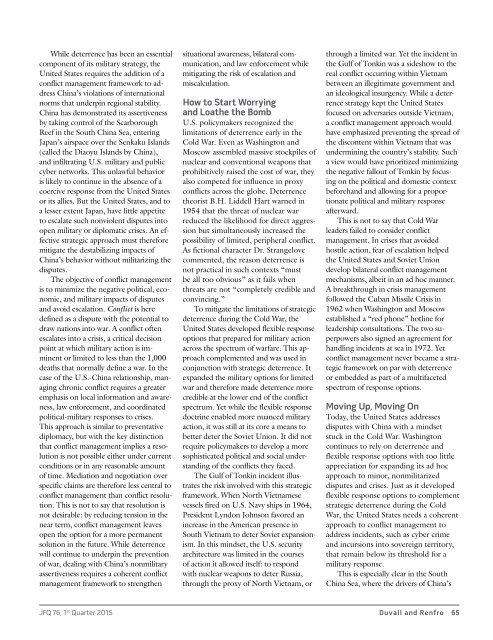jfq-76
jfq-76
jfq-76
You also want an ePaper? Increase the reach of your titles
YUMPU automatically turns print PDFs into web optimized ePapers that Google loves.
While deterrence has been an essential<br />
component of its military strategy, the<br />
United States requires the addition of a<br />
conflict management framework to address<br />
China’s violations of international<br />
norms that underpin regional stability.<br />
China has demonstrated its assertiveness<br />
by taking control of the Scarborough<br />
Reef in the South China Sea, entering<br />
Japan’s airspace over the Senkaku Islands<br />
(called the Diaoyu Islands by China),<br />
and infiltrating U.S. military and public<br />
cyber networks. This unlawful behavior<br />
is likely to continue in the absence of a<br />
coercive response from the United States<br />
or its allies. But the United States, and to<br />
a lesser extent Japan, have little appetite<br />
to escalate such nonviolent disputes into<br />
open military or diplomatic crises. An effective<br />
strategic approach must therefore<br />
mitigate the destabilizing impacts of<br />
China’s behavior without militarizing the<br />
disputes.<br />
The objective of conflict management<br />
is to minimize the negative political, economic,<br />
and military impacts of disputes<br />
and avoid escalation. Conflict is here<br />
defined as a dispute with the potential to<br />
draw nations into war. A conflict often<br />
escalates into a crisis, a critical decision<br />
point at which military action is imminent<br />
or limited to less than the 1,000<br />
deaths that normally define a war. In the<br />
case of the U.S.-China relationship, managing<br />
chronic conflict requires a greater<br />
emphasis on local information and awareness,<br />
law enforcement, and coordinated<br />
political-military responses to crises.<br />
This approach is similar to preventative<br />
diplomacy, but with the key distinction<br />
that conflict management implies a resolution<br />
is not possible either under current<br />
conditions or in any reasonable amount<br />
of time. Mediation and negotiation over<br />
specific claims are therefore less central to<br />
conflict management than conflict resolution.<br />
This is not to say that resolution is<br />
not desirable: by reducing tension in the<br />
near term, conflict management leaves<br />
open the option for a more permanent<br />
solution in the future. While deterrence<br />
will continue to underpin the prevention<br />
of war, dealing with China’s nonmilitary<br />
assertiveness requires a coherent conflict<br />
management framework to strengthen<br />
situational awareness, bilateral communication,<br />
and law enforcement while<br />
mitigating the risk of escalation and<br />
miscalculation.<br />
How to Start Worrying<br />
and Loathe the Bomb<br />
U.S. policymakers recognized the<br />
limitations of deterrence early in the<br />
Cold War. Even as Washington and<br />
Moscow assembled massive stockpiles of<br />
nuclear and conventional weapons that<br />
prohibitively raised the cost of war, they<br />
also competed for influence in proxy<br />
conflicts across the globe. Deterrence<br />
theorist B.H. Liddell Hart warned in<br />
1954 that the threat of nuclear war<br />
reduced the likelihood for direct aggression<br />
but simultaneously increased the<br />
possibility of limited, peripheral conflict.<br />
As fictional character Dr. Strangelove<br />
commented, the reason deterrence is<br />
not practical in such contexts “must<br />
be all too obvious” as it fails when<br />
threats are not “completely credible and<br />
convincing.”<br />
To mitigate the limitations of strategic<br />
deterrence during the Cold War, the<br />
United States developed flexible response<br />
options that prepared for military action<br />
across the spectrum of warfare. This approach<br />
complemented and was used in<br />
conjunction with strategic deterrence. It<br />
expanded the military options for limited<br />
war and therefore made deterrence more<br />
credible at the lower end of the conflict<br />
spectrum. Yet while the flexible response<br />
doctrine enabled more nuanced military<br />
action, it was still at its core a means to<br />
better deter the Soviet Union. It did not<br />
require policymakers to develop a more<br />
sophisticated political and social understanding<br />
of the conflicts they faced.<br />
The Gulf of Tonkin incident illustrates<br />
the risk involved with this strategic<br />
framework. When North Vietnamese<br />
vessels fired on U.S. Navy ships in 1964,<br />
President Lyndon Johnson favored an<br />
increase in the American presence in<br />
South Vietnam to deter Soviet expansionism.<br />
In this mindset, the U.S. security<br />
architecture was limited in the courses<br />
of action it allowed itself: to respond<br />
with nuclear weapons to deter Russia,<br />
through the proxy of North Vietnam, or<br />
through a limited war. Yet the incident in<br />
the Gulf of Tonkin was a sideshow to the<br />
real conflict occurring within Vietnam<br />
between an illegitimate government and<br />
an ideological insurgency. While a deterrence<br />
strategy kept the United States<br />
focused on adversaries outside Vietnam,<br />
a conflict management approach would<br />
have emphasized preventing the spread of<br />
the discontent within Vietnam that was<br />
undermining the country’s stability. Such<br />
a view would have prioritized minimizing<br />
the negative fallout of Tonkin by focusing<br />
on the political and domestic context<br />
beforehand and allowing for a proportionate<br />
political and military response<br />
afterward.<br />
This is not to say that Cold War<br />
leaders failed to consider conflict<br />
management. In crises that avoided<br />
hostile action, fear of escalation helped<br />
the United States and Soviet Union<br />
develop bilateral conflict management<br />
mechanisms, albeit in an ad hoc manner.<br />
A breakthrough in crisis management<br />
followed the Cuban Missile Crisis in<br />
1962 when Washington and Moscow<br />
established a “red phone” hotline for<br />
leadership consultations. The two superpowers<br />
also signed an agreement for<br />
handling incidents at sea in 1972. Yet<br />
conflict management never became a strategic<br />
framework on par with deterrence<br />
or embedded as part of a multifaceted<br />
spectrum of response options.<br />
Moving Up, Moving On<br />
Today, the United States addresses<br />
disputes with China with a mindset<br />
stuck in the Cold War. Washington<br />
continues to rely on deterrence and<br />
flexible response options with too little<br />
appreciation for expanding its ad hoc<br />
approach to minor, nonmilitarized<br />
disputes and crises. Just as it developed<br />
flexible response options to complement<br />
strategic deterrence during the Cold<br />
War, the United States needs a coherent<br />
approach to conflict management to<br />
address incidents, such as cyber crime<br />
and incursions into sovereign territory,<br />
that remain below its threshold for a<br />
military response.<br />
This is especially clear in the South<br />
China Sea, where the drivers of China’s<br />
JFQ <strong>76</strong>, 1 st Quarter 2015 Duvall and Renfro 65




